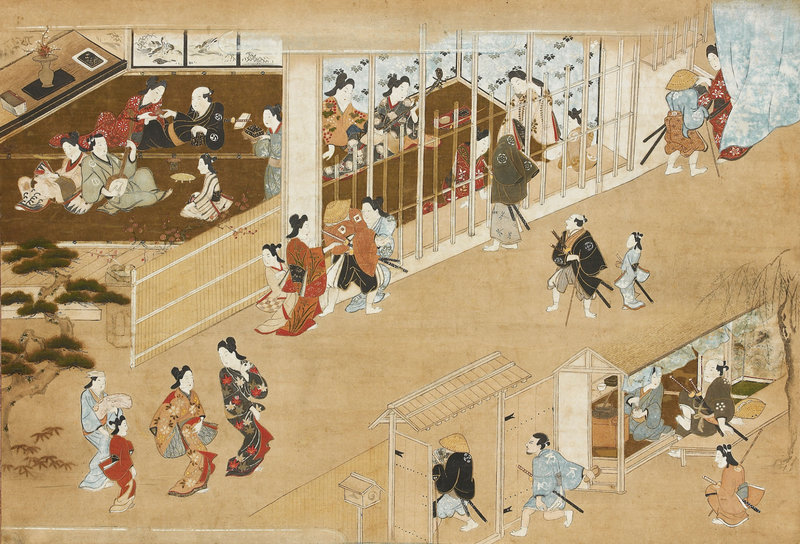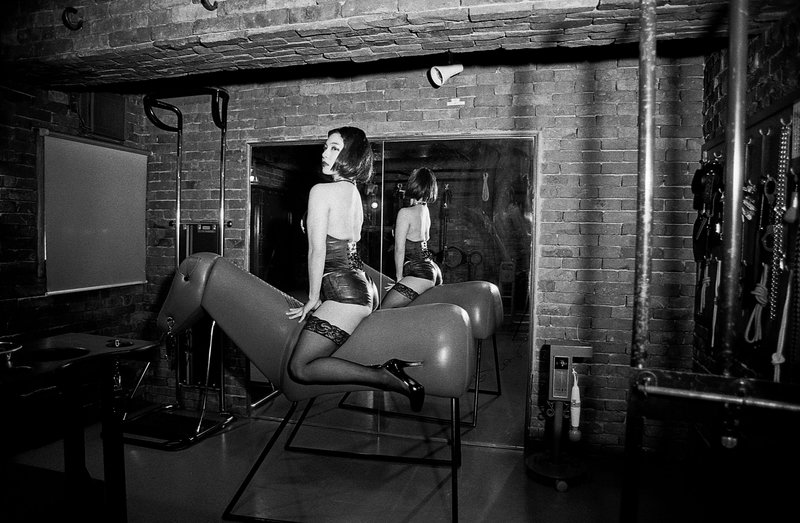'Tokyo: Art & Photography' at the Ashmolean until 3 January 2022
Ninagawa Mika (b. 1972), Tokyo from Utsurundesu series, since 2018. Models: AMIAYA © Ninagawa Mika, courtesy the artist and Tomio Koyama Gallery
Tokyo: Art & Photography is a celebration of one of the world’s most creative, dynamic and fascinating cities. Including works on loan from Japan and new commissions by contemporary artists, the show spans the exquisite arts of the Edo period (1603–1868) when the country was officially closed to the outside world; the iconic images of Hokusai and Hiroshige; to the photography of Moriyama Daido and Ninagawa Mika. The exhibition looks at a city which has undergone constant destruction and renewal, telling the stories of the people who have made Tokyo so famous with their insatiable appetite for the new and innovative.
Unknown artist in the style of Hishikawa Moronobu (1618–94), The Yoshiwara Pleasure Quarters, late 17th century. Hanging scroll, ink and colour on paper, 139.5 x91.2 cm, Ashmolean Museum, University of Oxford
The exhibition opens with an immersive installation by Ninagawa Mika (b. 1972), created for the Ashmolean, before providing an introduction to Tokyo’s evolution from a small fishing village known as Edo to the sprawling metropolis of the 21st century. Some of the most enduring impressions of Tokyo, familiar even to people who have never been to Japan, were made in Utagawa Hiroshige’s sublime series, One Hundred Famous Views of Edo (1856–9). These prints, showing the beauty spots of Tokyo through the seasons, were hugely popular, reflected in the European passion for Japonisme and obviously influenced the Impressionists. Printmakers and photographers have continued to respond to the changing city, showing landmarks such as Tokyo Tower or the networks of wires, roads and railways that have multiplied as Japan has grown into an economic powerhouse. Tokyo’s artists have long offered alternative and personal views of their city, reflecting on the experience of living in a place under intense development. Mohri Yuko’s fieldwork photos for her Moré, Moré (‘Leaky, Leaky’) project show the ingenious quick-fixes in the underground to plug holes and stop water leaking on commuters’ heads.
Utagawa Hiroshige (1797–1858), The Suijin Woods and Massaki on the Sumida River, from the series One Hundred Famous Views of Edo, 1856. Colour woodblock print, 55.9 x 40.6 cm.
Perhaps more than any other city on earth, Tokyo has had the constant need to rebuild and reinvent itself. An awe-inspiring list of natural disasters and catastrophes has necessitated repeated regeneration which has been recorded by the city’s artists and architects. A whole genre of woodblock prints, namazu-e, depicts the mythological giant catfish thought to live under the islands of Japan who would shake the earth at times of social and political discord. Hundreds of prints were produced within days of the Great Ansei Earthquake of 1855. They express sympathy for the people affected, veiled social criticism and even humour in pictures of merchants and builders who stood to profit from the event. When another massive earthquake hit Tokyo in 1923 an outpouring of grief and nostalgia flowed from the artistic community. Many works highlighted the destruction of symbols of Japan’s recent industrialisation, while the print series One Hundred Views of New Tokyo (1928–32) celebrated the dynamism of the city as it recovered from the devastation. This need to rebuild has created social and cultural tensions throughout Tokyo’s history. In the early decades of the 20th century the Edo period and its arts were celebrated as an era of peace, a better time when authentic Japanese culture flourished before western influences had taken route. Families who had lived in the city for generations were known as Edokko, living repositories of this history, analogous to London’s Cockneys. A sense of nostalgia for what was lost is entirely understandable following events like the firebombing of Tokyo in 1945 – the single most destructive bombing raid in history which, on one night (10 March), killed 83,000 people and left 1.5 million homeless. Photographers such as Kimura Ihei and Hayashi Tadahiko recorded the city’s devastating realities after the war.
Edo Castle from the album Record of Famous Sights of the Tokaido Road, Tosa school, late-17th century. Double page, 17.5 x 28.1 cm, Ashmolean Museum, University of Oxford
The resilience and creativity of the people who have lived through these conflagrations have maintained Tokyo’s national and international importance since the early 17th century. Until 1868 the city was known as Edo (meaning estuary, and the name of the military clan who first settled there). It came to prominence as the seat of the Tokugawa shoguns, Japan’s military rulers from 1603, who based themselves in Edo Castle (built in 1457). During this period Kyoto remained Japan’s official capital and home to the Emperor, who was the titular head of state. By the 18th century Edo had taken over as the nation’s cultural capital. With over a million inhabitants it was one of the largest cities in the world, a bustling centre where regional feudal lords (daimyo) would congregate with their retainers. With no wars to fight, they were hungry for entertainment and expected to be patrons and masters of the ‘arts of peace’: calligraphy, painting, the tea ceremony and no theatre all flourished under the shoguns. In the meantime ordinary townspeople, merchants and artisans, became increasingly wealthy and began to generate new art forms that reflected their own interests. They commissioned ukiyo-e, ‘pictures of the floating world’, showing dashing kabuki actors, sumo wrestlers and beautiful courtesans of the pleasure quarters.
Utagawa Kunimasa IV (1848–1920), Ryōunkaku Tower game (Ryounkaku kikaisugoroku),1890. Colour woodblock print with collage elementson paper, 72.7 x 25, Ashmolean Museum, University of Oxford.
When, in 1868, Emperor Meiji was restored as the as ruler of Japan, the policy of national isolation came to an end and rapid modernisation and westernisation swept the city. Students and artists who had travelled in Europe and America brought back fashions and ideas about modern art. In the Ginza shopping district western-style department stores like Mitsukoshi became cultural hubs selling imported products and hosting exhibitions. Prints from the 1930s represent a hybrid modernism, combining traditional artistic methods with modern palettes and contemporary scenes. Pictures of moga – from modan garu or modern girl – show young women with bobbed hair, make-up, short dresses and bare legs. Expressive photographs by artists such as Hosoe Eikoh and Naito Masatoshi present a highly subjective view on people’s lives in the city. Naito’s Tokyo: A Vision of its Other Side (1970–85) shows a dark face of the mega-city, focusing on the homeless and street entertainers. An installation by one of Japan’s greatest photographers, Moriyama Daido, includes a moving projection and atmospheric sounds of the city. Ninagawa Mika’s recent photographs of Tokyo (2018–19) offer a diaristic and personal look at the city, showing her friends and family and her experiences out clubbing.
Sugiura Hisui (1876–1965), Ginza Branch Open on April 10, 1930. Colour lithograph, 109.8 x 82.2 cm © The artist & Tokyo National Museum of ModernArt. Photo: Arrow Art Works, 2000
A rich artistic tradition, now famous the world over, is to be found in Tokyo’s entertainment and sex culture. From the Edo period right up to the 20th century, bijinga (pictures of beautiful women) and shunga (erotic ‘spring pictures’) were among the most popular and sought-after subjects by ukiyo-e artists. Scrolls and prints were hotly traded in the tea-houses, theatres and bars of the Yoshiwara pleasure district. Although depictions of women by male artists were diverse, ranging from courtesans to female samurai, ghosts and monsters, it was not until the 20th century that women were able to exert more agency in depictions of female sexuality. Tokyo Rumando’s Rest 3000, Stay 5000 (2012) is a series of self-portraits where the artist imagines herself as different women who go to love hotels. Tsuzuki Kyoichi’s 2001 photobook, Satellite of Love, explores the phenomenon of love hotels, focusing on their fantastical interior design.
Tokyo Rumando, Rest 3000~ Stay 5000~, 2012. Gelatin silver print, 28 x 35.6 cm © Tokyo Rumando, courtesy ZenFoto Galleryand IBAS
With so many creative and cultural forces intersecting in Tokyo, the city has become a world-renowned centre of avant-garde art. Experimentation can be traced from Utagawa Kuniyoshi’s Courtesan Usugumo printed with newly imported Prussian Blue pigment in 1835; the Creative Print artists of the 1920s and ‘30s; to the painters and designers who combined bright colours with traditional motifs in Tokyo Pop. Particular innovation was made by 20th-century performance and protest artists. Hirata Minoru’s photos document works by the Hi Red Center artist collective like Cleaning Event (1964), a ‘happening’ which reacted to the government’s ‘cleansing’ of neighbourhoods before the 1964 Tokyo Olympics. More recently one of Japan’s best-known artists, Murakami Takashi, has blurred the lines between popular sub-culture and ‘high art’, creating unique Pop Art paintings that he has defined as ‘super flat’. Aida Makoto provocatively links traditional painting techniques with contemporary manga styles to illustrate problems in Japanese society. Four of his students are members of the young, sociocritical art collective ChimPom, whose performative works on the streets of Tokyo are inextricably intertwined with their lives: Love is Over (2014) was a work of art based on the wedding of one of their members, Ellie, as well as a public demonstration for love in Shinjuku.
Utagawa Kuniyoshi (1797–1861), The kabuki actor Ichikawa Kuzo II in the role of the footman Yokanbei, with a view of Mount Fuji from the Denmacho District, 1856, Colour woodblock print , 60.4 x 45 cm, Ashmolean Museum, University of Oxford.
Dr Xa Sturgis, Director of the Ashmolean, says: ‘ With its tumultuous history and extraordinarily rich artistic output, Tokyo is one the most exciting cultural hotspots on the globe. In showcasing this exceptional range of artworks from the 17th century right up to pieces made in 2021, and precious works on loan from Japan, the exhibition promises to be a thrilling and unusual insight into Tokyo, one of the most interesting cities in the world.’
29 July 2021–3 January 2022
Utagawa Hiroshige (1797–1858), Maple Trees at Mama, Tekona Shrine and Linked Bridge from One Hundred Famous Views of Edo,1857. Woodblock print on paper, 34.9 x 23.5 cm, Ashmolean Museum, University Oxford
Maekawa Senpan (1888–1960), Subway, from the series ‘One Hundred New Views of Tokyo’, 1931. Colour woodblock print, 20 x 26 cm, Ashmolean Museum, University of Oxford
Onchi Koshiro (1891–1955), Tokyo Station, from the series Views of Last Tokyo, 1945. Colour woodblock print, 44.5 x 31.7 cm, Ashmolean Museum, University of Oxford © The artist.
Yamashita ikuji (1919–86), Bunker-1, 1966. Oil on canvas, 130 x 194 cm © The artist. Courtesy Gallery Nippon, Tokyo
Shinohara Ushio (b. 1932), Doll Festival, 1966. Triptych of colour screenprints on paper, each sheet 71.1 x 144.9 cm, Ashmolean Museum, University of Oxford © Ushio and Noriko Shinohara.
Tanaami Keiichi (b. 1936), No More War,1968 (detail shown above). Silk screen print on paper, 103 x 72.8 cm © Tanaami Keiichi, courtesy of NANZUKA
Hosoe Eikoh, (b. 1933), Simmon: a Private Landscape, 1971. Gelatin silver print, 50 x 60cm © Hosoe Eikoh, courtesy the artist and Akio Nagasawa Gallery | Publishing, Tokyo.
Aida Makoto, Uguisudani-zu, 1990. Panel, sex phone calling cards, Japanese mineral pigment, acrylic. Private Collection © Aida Makoto, courtesy the artist and Mizuma Art Gallery
Sugiyama Mototsugu (1925–2018), Good Evening Sumida River, 1993. Colour woodblock print, 55 x 72.5 cm, Ashmolean Museum, University of Oxford © The Artist
Machida Kumi (b. 1970), Three Persons, 2003. Sumi ink and mineral pigments on kumohada linen paper, Y’s Collection © Machida Kumi, courtesyNishimura Gallery
Nishino Sohei (b. 1983), Diorama Map Tokyo, 2004. Light jet print on Kodak Endura paper, 80 x 80 cm © Nishino Sohei, courtesy Michael Hoppen Gallery, London
Moriyama Daido (b. 1938), Untitled, 2006. Gelatin silver print, 27.9 x 35.5 cm © Daido Moriyama Photo Foundation, Tokyo.
Takano Ryudai (b. 1963), Tokyo Tower (2011.03.11) from Daily Snapshots, 2014 © The artist and Yumiko Chiba Associates, Tokyo

/https%3A%2F%2Fprofilepics.canalblog.com%2Fprofilepics%2F1%2F0%2F100183.jpg)
/https%3A%2F%2Fstorage.canalblog.com%2F03%2F02%2F119589%2F96711876_o.jpg)
/https%3A%2F%2Fstorage.canalblog.com%2F11%2F31%2F119589%2F94773502_o.jpg)
/https%3A%2F%2Fstorage.canalblog.com%2F20%2F83%2F119589%2F94772815_o.jpg)
/https%3A%2F%2Fstorage.canalblog.com%2F26%2F72%2F119589%2F75604929_o.jpg)
/https%3A%2F%2Fstorage.canalblog.com%2F59%2F60%2F119589%2F26458628_o.jpg)























/http%3A%2F%2Fstorage.canalblog.com%2F51%2F86%2F119589%2F127782228_o.jpg)
/http%3A%2F%2Fstorage.canalblog.com%2F76%2F58%2F119589%2F127243024_o.jpg)
/image%2F1371349%2F20240423%2Fob_b2fe42_telechargement-9.jpg)
/image%2F1371349%2F20240423%2Fob_af8bb4_telechargement-6.jpg)